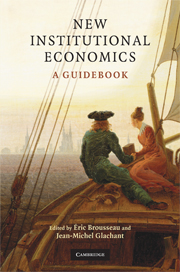Book contents
- Frontmatter
- Contents
- List of tables
- List of figures
- List of contributors
- Acknowledgements
- Foreword
- A Road Map for the Guidebook
- Introduction to New Institutional Economics: A Report Card
- Part I Foundations
- Part II Methodology
- Part III Strategy and Management
- Part IV Industrial Organization
- Part V Institutional Design
- Part VI Challenges to Institutional Analysis
- 19 Law and Economics in Retrospect
- 20 The Theory of the Firm and Its Critics: A Stocktaking and Assessment
- 21 The Causes of Institutional Inefficiency: A Development Perspective
- Notes
- References
- Index
20 - The Theory of the Firm and Its Critics: A Stocktaking and Assessment
Published online by Cambridge University Press: 06 July 2010
- Frontmatter
- Contents
- List of tables
- List of figures
- List of contributors
- Acknowledgements
- Foreword
- A Road Map for the Guidebook
- Introduction to New Institutional Economics: A Report Card
- Part I Foundations
- Part II Methodology
- Part III Strategy and Management
- Part IV Industrial Organization
- Part V Institutional Design
- Part VI Challenges to Institutional Analysis
- 19 Law and Economics in Retrospect
- 20 The Theory of the Firm and Its Critics: A Stocktaking and Assessment
- 21 The Causes of Institutional Inefficiency: A Development Perspective
- Notes
- References
- Index
Summary
Introduction
Since it emerged in the early 1970s new institutional economics (NIE) has been the subject of intense debate. As an important part of NIE, the modern theory of the firm – mainly transaction cost economics (TCE) and property rights theory, but also agency theory and team theory – is no exception. Much of the debate on the theory of the firm has been “internal,” in the sense that it has been conducted between scholars who are generally sympathetic to the new institutional approach (e.g. Hart 1995; Kreps 1996; Maskin and Tirole 1999; Brousseau and Fares 2000; Foss and Foss 2001; Furubotn 2002; MacLeod 2002).
However, there also exists a substantial, though somewhat amorphous, set of “external” critiques, arising from sociologists, heterodox economists (“old” institutionalist, Austrian, and evolutionary), and management scholars, mainly in the organization and strategy fields. Williamson's TCE has been a favorite Prügelknabe for about three decades (e.g. Richardson 1972; Hodgson 1989; Perrow 2002), but agency theory has also drawn a fair amount of fire (Donaldson 1996). For instance, early critics argued that TCE ignored the role of differential capabilities in structuring economic organizations (Richardson 1972); neglected power relations (Perrow 1986), trust, and other forms of social embeddedness (Granovetter 1985); and overlooked evolutionary considerations, including Knightian uncertainty and market processes (Langlois 1984). Such critiques have been echoed and refined in numerous contributions, and criticizing NIE remains a thriving industry.
- Type
- Chapter
- Information
- New Institutional EconomicsA Guidebook, pp. 425 - 442Publisher: Cambridge University PressPrint publication year: 2008
- 20
- Cited by



